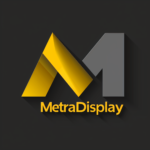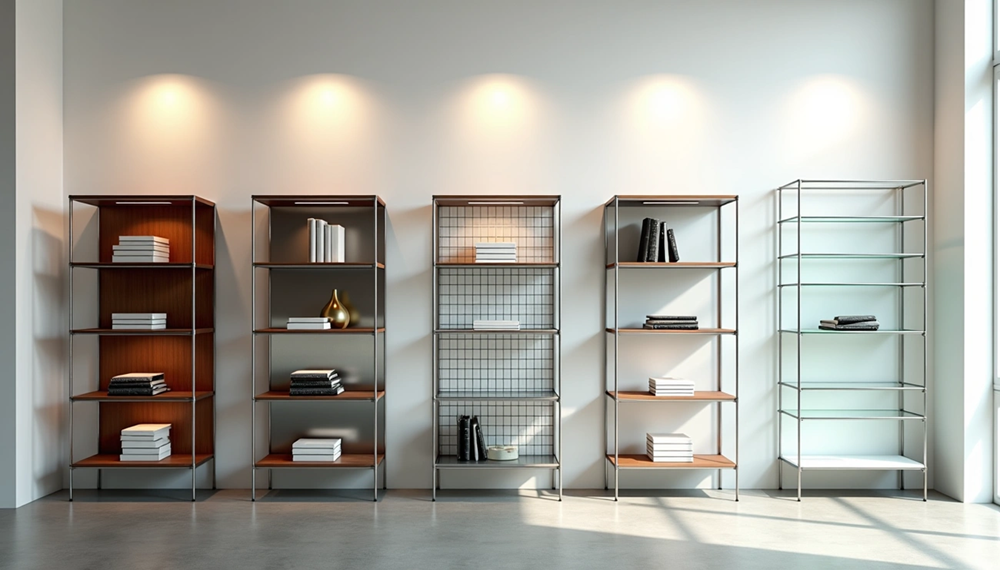
Your choice of shelving material can make or break a retail display. A surprising 40% of homeowners choose wood for their new shelves. This trend mirrors the retail sector, where shelf materials play a crucial role in both function and shopper experience.
Several key factors determine the best shelving material for a shop. Durability, weight capacity, visual appeal, and cost all shape the final decision. To name just one example, metal shelves excel at supporting heavy items, while glass creates an upscale look that can lift certain retail spaces. The right shelf material can substantially improve store layout and space usage across retail settings.
Retailers can pick from classic wood, sturdy metal, versatile wire, practical plastic, and sophisticated glass. Each option brings its mix of strength, value, and ideal store placement. Display shelving remains vital to any retail space. It helps products stand out and draws customers in. This piece gets into the five best materials for shop shelves, giving store owners the insights they need for their 2025 retail spaces.
Wood Shelving
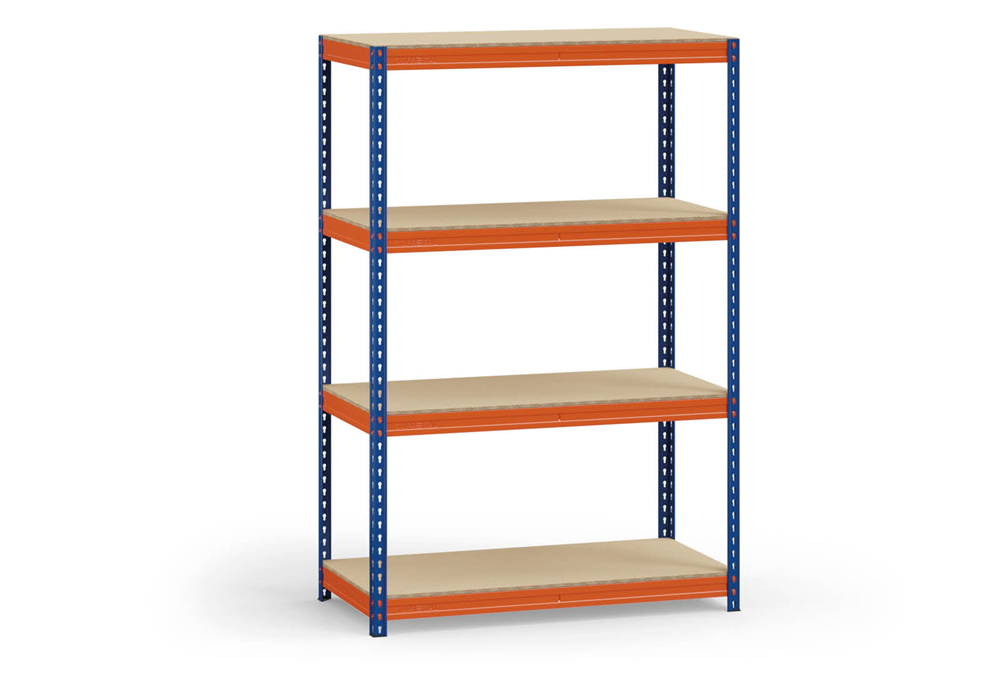
Wood stands out as a favorite among retail shopfitters who know how to balance looks and function. The natural warmth and strong structure make wood an enduring material for shelves in retail spaces of all types.
Wood shelving overview
Wooden display racks create inviting and memorable retail spaces right away. The natural look of wooden furniture and floor displays has made them essential in businesses of all sizes. These adaptable fixtures come in many setups, including:
- Crate and basket stands for bulk products
- Etageres for easy merchandise viewing
- Display carts for unique merchandising needs
- Wood bookcases and hutches for heavier products
- Wall shelves for decorative wall accents
Pine, oak, maple, and mahogany are the most popular wood finishes. Each type of wood brings its own look and performance features. Oak and maple lead the pack because they look great and last long. Retailers can pick from ready-made pieces or get custom solutions that match their exact needs.
Wood shelving benefits
Wood’s appeal as a shelving material goes beyond just looks. Wooden retail racks offer several advantages:
- Enhanced Visual Merchandising: Wood shelving shows off merchandise and makes products catch the eye naturally.
- Brand Image Enhancement: Wood displays create an inviting brand image and showcase products well. Many brands look for natural materials that match their green values.
- Customization Options: Custom-milled wood shelving can match a store’s door frames, window frames, blinds, and moldings. This creates a unified space that makes customers feel good.
- Environmental Benefits: Wood is the only building material that helps fight climate change. Retailers who care about the environment like that properly sourced wood shelving can be FSC-certified, meeting global standards for responsible forestry.
- Versatility: Wooden retail shelving units shine at creating that rustic look you see in country stores, craft shows, and local grocery markets.
Wood display racks set and keep a store’s mood without trying too hard. This makes wood an excellent shelving material option that creates unique shopping experiences. Customers don’t just come once – they keep coming back.
Wood shelving durability and load capacity
Wood shelf strength changes a lot based on the type of wood and how it’s built. Solid hardwoods can hold much more weight than engineered woods.
A ¾-inch thick plywood shelf with support every 36 inches holds heavy loads without sagging. This thickness gives great strength and stability because of its layered build. It won’t warp as much as solid wood.
Tests show that Baltic birch plywood with poplar edging tops the list of best shelf material options. It showed no sag over a 42-inch span with 64 pounds of weight. You can get a 4×8′ sheet for about $70.
Solid pine with edge treatment did better than expected. It earned a zero-sag rating at 36 inches and beat oak in the edged categories. Oak worked better when used without edges, though.
The space between supports matters a lot:
- For 18mm (¾ inch) solid wood: Support every 700mm (27.5 inches)
- For 25mm (1 inch) solid wood: Support every 900mm (35.5 inches)
For heavy stuff or spans over 48 inches, try gluing two ¾-inch pieces together to make a 1½-inch thick shelf.
Wood shelving pricing
Prices swing widely between wood types and how they’re made:
| Wood Type | Approximate Cost | Notes |
|---|---|---|
| Oak veneer plywood | $45 per 4×8′ sheet | Looks good and won’t bend much up to 36″ |
| Baltic birch plywood | $70 per 4×8′ sheet | Strongest in tests but looks plain next to solid wood |
| Solid oak | $3.75 per board foot | No need for edges unless shelves go past 48″ |
| Solid pine | $4.29 per board foot (select grade) | Good value if supported right |
U.S.-made wooden retail fixtures often cost the same as overseas options thanks to North America’s abundant forests. Making things here means shorter wait times too – that’s huge with today’s supply chain issues.
Wood shelving ideal use cases
Wood shelving shines in retail spaces where atmosphere makes or breaks the customer experience:
Specialty retail: Wood adds warmth and class to store displays. It needs more care to look good, but wooden shelves make products feel more premium.
Pharmacies, clothing stores, and jewelry shops: These places benefit from wood’s warm, tasteful displays that look great while staying strong enough for most items.
Country stores, craft shows, and local markets: Wooden retail shelving units fit these settings perfectly.
Food and wine displays: Wooden display racks make everything look better, especially food, wine, and housewares.
Brand-conscious retailers: Stores that want to show they care about nature and sustainability find wood is the best material for shelves to get that message across.
Wood shelving does two jobs at once – it shows off merchandise while helping build the store’s brand and feel. Shop fitters have found that the right wooden shelving changes ordinary stores into special places that keep customers coming back and make products look their best.
Metal Shelving
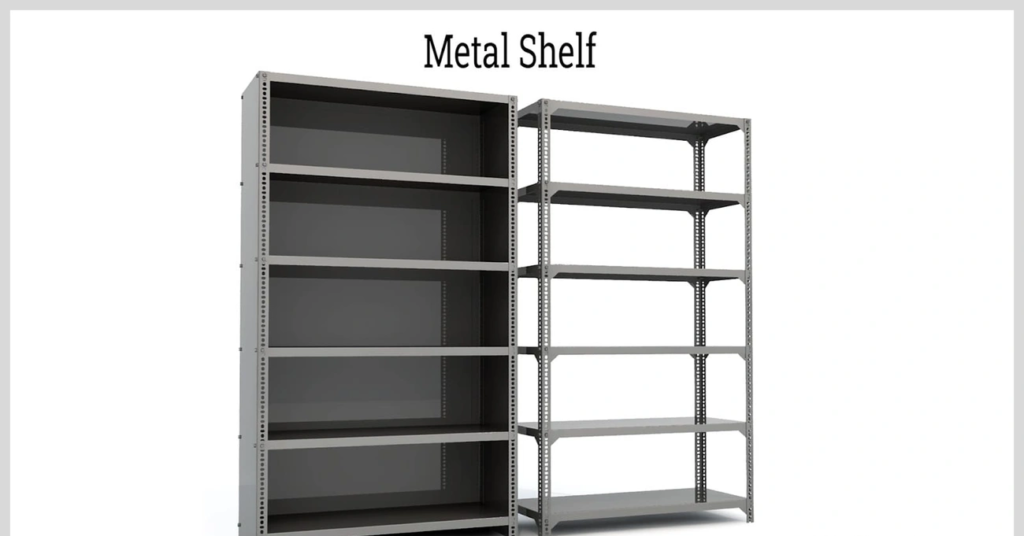
Metal shelving is the life-blood of retail displays because of its strength and versatility. Our experience as shop fitters shows how metal has changed commercial spaces with its reliable construction and sleek design options.
Metal shelving overview
Metal shelving covers several variations that suit different retail environments. You’ll find solid steel shelving, stainless steel options, and chrome wire configurations. Steel shelving comes with vertical slotted uprights that fit metal shelves in various sizes. These shelves come in popular finishes like white, off-white, black, or chrome.
Wire shelving deserves a closer look. It uses thick wire in a cross-square pattern. This creates a grid-like structure that lets you see through it and allows air to flow. Solid metal shelves give complete surface coverage and can hold more weight.
Today’s metal shelving systems feature modular designs. You can click and lock components without tools. This state-of-the-art design lets retailers rearrange their display spaces as their needs change.
Metal shelving benefits
Metal offers many advantages that make it valuable in retail environments when you choose a shelving material:
- Exceptional Durability: Metal shelves last longer than shelving material options like wood or plastic. They resist damage from heavy loads, moisture, and pests. You can count on them to stay sturdy in demanding retail environments.
- Space Optimization: Metal shelving helps you use vertical space without taking up more floor area. This works great in smaller retail spaces where every square foot counts.
- Organizational Efficiency: Products stay visible and well-organized. This makes inventory management easier. The right shelf setup and labels help you find items quickly.
- Customization Flexibility: You can adjust shelf heights and use modular designs. Add bins and dividers to fit merchandise of any size and shape.
- Minimal Maintenance: A simple wipe-down keeps metal shelves clean. This makes them perfect in busy retail environments.
Metal shelving’s strength and stability improve product safety and reduce damage risk. Your merchandise and customers stay safer.
Metal shelving durability and load capacity
Metal proves to be the best material for shelves in pure strength. Heavy-duty steel shelving systems hold weights that would break other materials. Some shelves can hold hundreds or thousands of pounds [12].
Load capacities change based on design and construction:
| Type | Typical Weight Capacity | Example |
|---|---|---|
| Standard Wire Shelving | 350 lbs per shelf | 6-tier units with 2100 lbs total capacity |
| Heavy-Duty Steel Racks | Up to 800 lbs at 48″ height | Chrome wire shelving units |
| Industrial Metal Shelves | 2,000 lbs per shelf | 12-gauge steel construction |
The right installation and weight distribution keep shelves from buckling under heavy loads. Support spacing and shelf thickness play key roles in how much weight they can hold.
Metal shelving pricing
Metal shelving proves to be a smart investment despite higher upfront costs than other shelving material options. Prices vary based on type, finish, and quality:
- Chrome wire shelving costs less than stainless steel
- Stainless steel shelving costs more but resists corrosion better
- Metal aspect retail display shelves start at around $40 for 24″ lengths
The upfront cost might be higher, but metal shelving gives you great long-term value. It lasts longer and needs fewer replacements. You save money over time because it needs little maintenance.
Metal shelving ideal use cases
Our shopfitting experience shows that metal shelving works well in retail sectors of all types:
Retail stores love metal shelving systems. These fixtures display products well and use space efficiently. Metal shelves handle daily retail wear and tear with ease.
Food service businesses choose wire configurations. The air circulation keeps food fresh and meets safety rules.
Healthcare facilities prefer metal shelving because it’s easy to clean and stores items securely. Medical supplies stay organized while meeting hygiene standards.
Industrial and warehouse operations rely on metal shelving for inventory. These shelves hold heavy items and give quick access.
Specialty retailers going for a modern look pick metal shelving. The clean lines and sleek style create an upscale feel.
Retail spaces that change often benefit from modular metal shelving. They can adapt quickly to new merchandising plans.
Wire Shelving
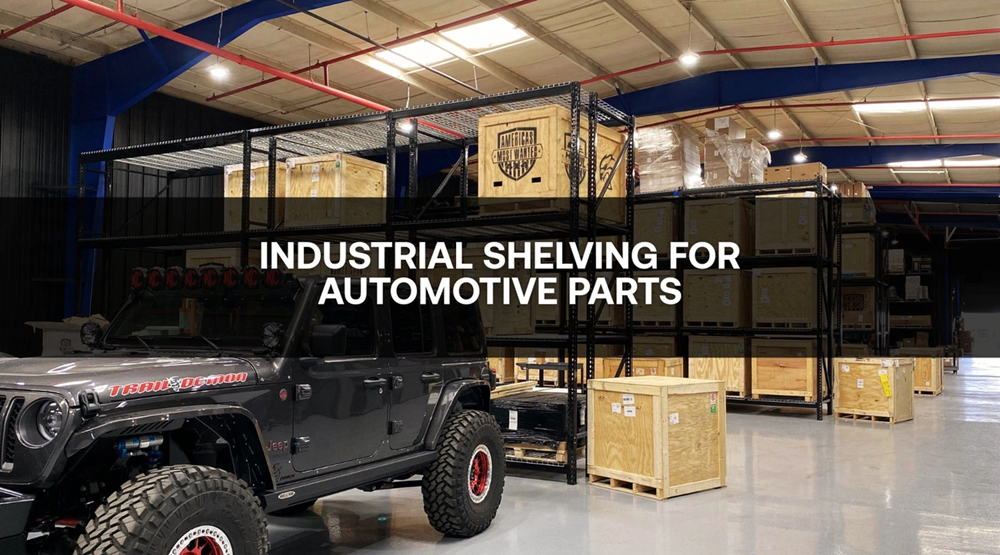
Wire shelving stands out as a practical solution in retail fixtures. It combines functionality with ease of use. Our years as shopfitting suppliers have shown us how these open-grid designs change storage capabilities in a variety of commercial settings.
Wire shelving overview
Wire shelving consists of high-strength steel wire mesh arranged in a cross-square pattern that creates a grid-like structure balancing strength with visibility. The open design lets light and air pass through freely, unlike solid shelves. These units feature vertical posts and horizontal shelves that adjust at regular intervals—usually in 1-inch increments.
You’ll find wire shelving systems in several finishes, including chrome-plated, black powder-coated, and stainless steel options. The design lets you assemble without tools using snap-together components for quick setup [4]. Our experience as shopfitting specialists shows this simple assembly gives retailers a great advantage when they need to change their displays often.
Wire shelving benefits
Wire shelving offers unique advantages that make it valuable for retail spaces compared to other shelving material options:
- Superior ventilation: The open-grid design helps air flow freely. This prevents dust buildup and reduces moisture accumulation—key features for products that need ventilation.
- Enhanced visibility: Products are easy to spot and locate quickly with wire shelving. This helps stockroom staff manage inventory better.
- Hygiene and cleanliness: Cleaning becomes a breeze with the open structure that contains spills. This makes wire shelving perfect for spaces where cleanliness matters most.
- Customization flexibility: Retailers can adjust shelf layouts to fit merchandise of different sizes. This adaptability proves valuable as retail needs change.
- Space optimization: The design maximizes vertical storage while keeping dust away, which helps use space more efficiently.
Wire shelving brings together strength, visibility, and adaptability in ways solid shelving can’t match. It’s often the best material for shelves for retail spaces.
Wire shelving durability and load capacity
Durability plays a key role in choosing shelving material. Wire shelving shows remarkable strength-to-weight ratios with varying weight capacities:
| Type | Weight Capacity | Construction |
|---|---|---|
| Standard Wire | 350-500 lbs per shelf | Welded wire construction |
| Heavy-Duty | Up to 800 lbs per shelf | All-welded with trussing |
| Commercial Grade | 800-1,250 lbs per shelf | Heavy-duty steel construction |
The open wire design spreads weight evenly across the shelf surface. This prevents pressure points and keeps the structure strong even with heavy loads. You can store everything from kitchen appliances to bulky inventory safely.
Wire shelving pricing
Wire shelving costs less than other shelving material options. Prices vary based on construction quality, finish type, and weight capacity:
A standard 4-tier unit measuring 36 inches wide by 54 inches high starts at $55-65. Heavy-duty commercial options that hold more weight cost around $139 for a 6-tier unit measuring 48 inches wide by 72 inches high.
Price depends on:
- Finish type (chrome costs less than stainless steel)
- Weight capacity (stronger shelves cost more)
- Size dimensions (larger units have higher prices)
- Casters or special accessories
The long-term value makes up for the upfront cost. These shelves last long and need little maintenance. Retailers looking for the best material for shelves often choose wire shelving for its mix of affordability and performance.
Wire shelving ideal use cases
Our shopfitting experience shows that wire shelving works best in specific retail settings:
Retail stores: Stockrooms and storage areas benefit from wire shelving’s visibility and organization. Staff can find inventory quickly while maximizing storage space.
Food service: Restaurants and commercial kitchens love wire shelving’s ventilation features. Food stays fresh longer and meets safety regulations thanks to the open design.
Healthcare facilities: Medical spaces prefer wire shelving because it’s easy to clean and stops dust buildup. This helps maintain strict hygiene standards.
Offices: Wire shelving stores supplies, documents, and equipment efficiently. You can adjust shelves to fit different items while keeping everything visible.
Warehouses and distribution centers: The strength and durability make wire shelving perfect for storing heavy items securely.
Our experience as shopfitting suppliers shows that wire shelving remains one of the most versatile shelving material choices for modern commercial spaces.
Plastic Shelving
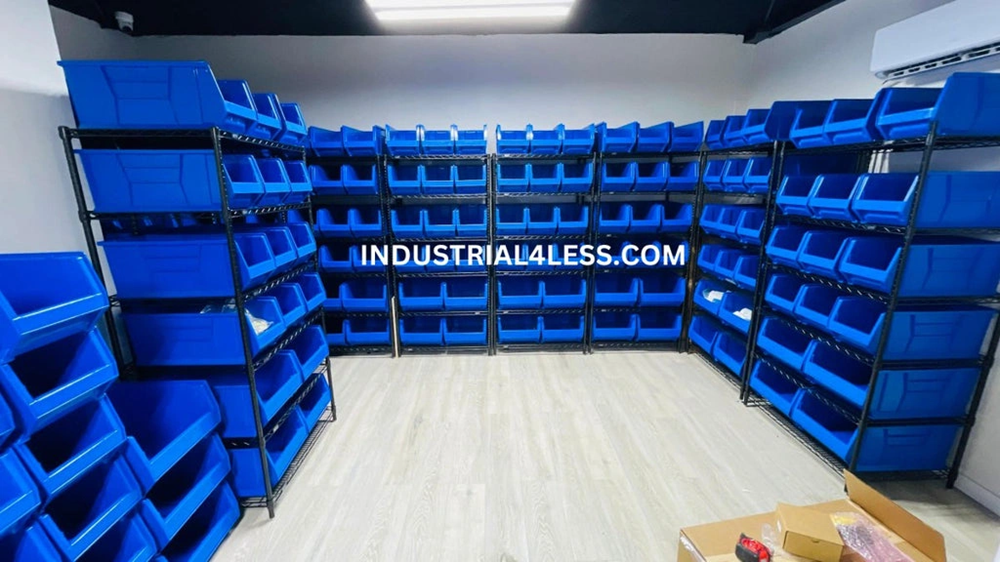
Plastic shelving stands out as a versatile material for shelves in commercial spaces where durability meets practicality. Our years as shop fitting specialists have shown us how this lightweight yet resilient option brings great advantages to specific retail applications.
Plastic shelving overview
Modern plastic shelving units use high-density polyethylene (HDPE) or polypropylene, engineered specifically for commercial applications. These advanced polymers create shelves that hold up in demanding environments without losing structural integrity. Most units come with ventilated shelf designs that promote airflow and stop mold and mildew from forming.
Commercial plastic shelves come in different setups, usually with multiple tiers of 4-5 shelves per unit. These shelving systems include useful features like adjustable leveling feet that work on uneven surfaces and interlocking capabilities to connect multiple units safely.
Plastic shelving benefits
Among shelving material options of all types, plastic brings several key advantages:
- Chemical Resistance: Plastic shelves resist chemicals remarkably well, making them perfect for janitorial supply rooms and places that store cleaning agents.
- Sanitation Excellence: Plastic shelving’s antimicrobial protection helps meet hygiene standards needed in healthcare and food service settings.
- Corrosion Immunity: Plastic shelving never rusts or corrodes, unlike metal options. It keeps its look and strength even in humid spaces.
- Easy Maintenance: You can wipe surfaces clean easily. Many polymer shelves are dishwasher safe, which makes cleaning spills simple.
- Lightweight Construction: Plastic weighs about half as much as glass of the same size. This makes setup and rearrangement much easier.
Plastic shelving durability and load capacity
In stark comparison to what many think, today’s commercial plastic shelving can handle impressive weights:
| Type | Shelf Capacity | Total Unit Capacity |
|---|---|---|
| Standard | 150-200 lbs per shelf | 750 lbs |
| Heavy-Duty | 250-340 lbs per shelf | Up to 1,250 lbs |
| Industrial | 460-675 lbs per shelf | 2,000+ lbs |
Advanced manufacturing creates impact-resistant surfaces that give plastic shelving its strength. Some commercial-grade options include UV protection to prevent sun damage. Industrial-grade plastic shelving systems are tough enough to handle almost any challenge, making them ideal for harsh environments.
Plastic shelving pricing
Our shopfitting experience shows that plastic shelving offers excellent value. Here’s what you can expect to pay:
- Entry-level 4-tier units (36″ width): Starting around $395
- Mid-range 5-tier units (48″ width): Starting around $585
- Premium heavy-duty units (66″-96″ width): $605-$715
Price changes depend on size, weight capacity, and special features like chemical resistance or antimicrobial protection. The upfront cost might be more than simple wire shelving, but you’ll save money over time through less maintenance and fewer replacements.
Plastic shelving ideal use cases
Our years in shopfitting show that plastic shelving works best in specific settings:
Food service establishments love plastic shelving’s moisture resistance and sanitation properties. Health inspectors like the corrosion-free look and food-safe materials.
Laboratory and healthcare settings need the chemical resistance and antimicrobial properties that plastic provides. Healthcare facilities often choose plastic shelving because it stays clean and prevents contamination.
Cold storage environments work well with plastic shelving because it performs great in refrigerated spaces without metal’s condensation problems.
Chemical storage areas need shelves that won’t corrode or break down. Plastic’s chemical resistance makes it the best shelf material for cleaning supplies and other corrosive substances.
Retailers looking for the best shelving material in tough environments will find that plastic combines durability, cleanliness, and value in a way that deserves a close look.
Glass Shelving
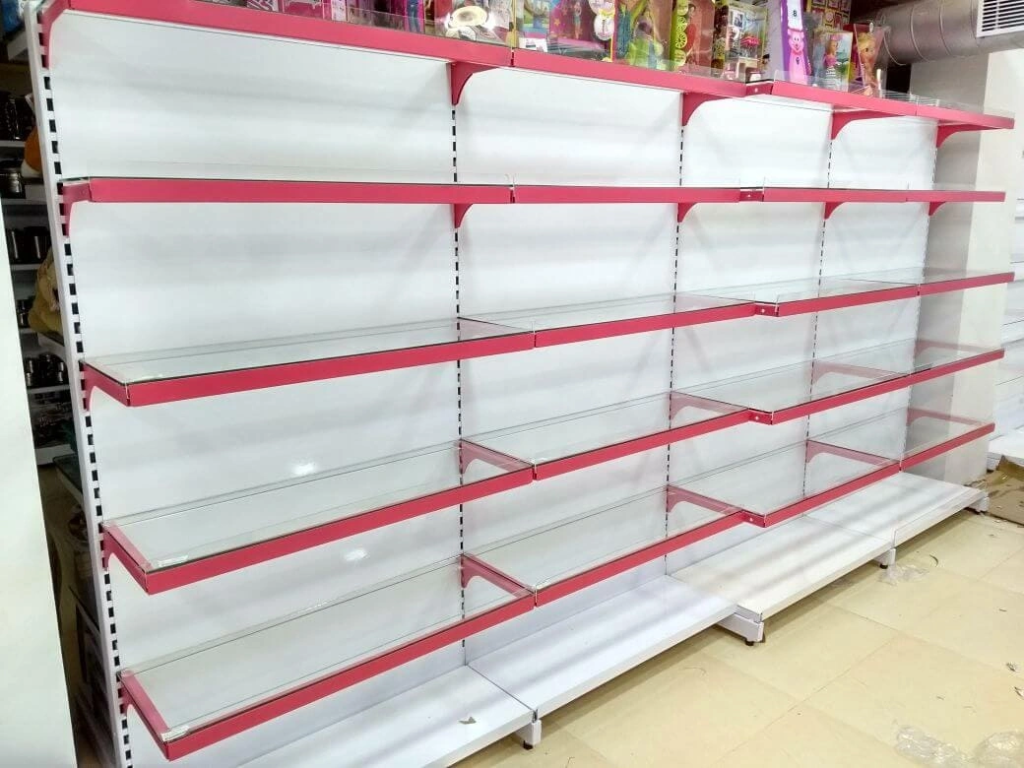
Glass shelving improves retail displays through elegant transparency and sleek design. Our 12 years as shopfitting specialists have shown us how this premium material for shelves changes ordinary retail spaces into sophisticated shopping environments.
Glass shelving overview
Tempered glass leads the retail shelving market with superior strength and safety features. These shelves range from 3/16″ to 1/2″ thick, with thinner options being standard for most applications. The pencil-polished edges look great and keep everyone safe by removing sharp corners. Most retailers choose depths between 8″ to 14″ and lengths from 24″ to 48″ to meet their display needs.
Glass shelving benefits
Glass creates unique advantages as a shelving material through its transparency:
- Products remain visible from every angle without obstruction
- Light reflects to make spaces look brighter and more open
- Glass resists moisture perfectly and won’t rust or corrode in humid spaces
- A warm, damp cloth is all you need for quick cleaning
- The natural look works with any décor and existing fixtures
Customers tend to handle merchandise more carefully when displayed on glass, which reduces product damage.
Glass shelving durability and load capacity
Many retailers are surprised to learn that tempered glass is about four times stronger than regular annealed glass. Standard tempered glass handles 24,000 psi, while regular glass manages just 6,000 psi. Load capacity depends on thickness and support placement:
| Glass Type | Strength Multiplier | Notes |
|---|---|---|
| Annealed Glass | Base strength | Breaks into dangerous shards |
| Tempered Glass | 4x stronger | Shatters into small, safer pieces |
Heavy items should sit in the center of tempered glass shelves where tension stays strongest.
Glass shelving pricing
Glass shelving offers great value as the best shelf material for premium displays:
- 8″ x 24″ tempered glass shelves: Starting at $7.50
- 10″ x 24″ tempered glass shelves: Starting at $8.00
- 12″ x 48″ tempered glass shelves: Starting at $15.75
- 14″ x 48″ tempered glass shelves: Starting at $19.50
Careful crating for shipping usually adds about $25 to orders.
Glass shelving ideal use cases
Our shop fitting experience shows that glass shelving works best in these retail settings:
- Jewelry stores: Makes precious items stand out in an upscale setting
- Boutique clothing stores: Adds a sophisticated touch to folded clothing
- Cosmetics and beauty retailers: Creates premium product displays
- Gift shops: Gives special items an exquisite look
- Art galleries and collectibles shops: Shows items without distracting from them
As your trusted shopfitting suppliers, we suggest glass shelving for displays that need both elegance and durability. This strategic choice turns ordinary merchandise into premium offerings.
Comparison Table
| Material | Weight Capacity | Key Benefits | Ideal Use Cases | Price Range | Durability Features |
|---|---|---|---|---|---|
| Wood | 64 lbs (zero sag at 42″) for Baltic birch plywood | – Natural warmth and esthetics – Improved visual merchandising – Customization options – Environmental benefits | – Specialty retail – Pharmacies – Clothing stores – Country stores – Food/wine displays | $45-70 per 4×8′ sheet (plywood) $3.75-4.29 per board foot (solid) | – Solid hardwoods perform better than engineered woods – Support needed every 27.5-35.5″ depending on thickness |
| Metal | Up to 2,000 lbs per shelf (industrial grade) | – Outstanding durability – Space optimization – Minimal maintenance – Customization flexibility | – Retail stores – Food service – Healthcare – Industrial/warehouse | Starting at $40 for 24″ lengths | – Resistant to damage – Moisture resistant – Pest resistant |
| Wire | 350-1,250 lbs per shelf | – Superior ventilation – Improved visibility – Easy cleaning – Space optimization | – Retail stockrooms – Food service – Healthcare – Warehouses | $55-65 (simple 4-tier) $139+ (commercial grade) | – Even weight distribution – Open design prevents pressure points |
| Plastic | 150-675 lbs per shelf | – Chemical resistance – Antimicrobial protection – Corrosion immunity – Easy maintenance | – Food service – Healthcare – Cold storage – Chemical storage | $395-715 depending on size and capacity | – Impact resistant – UV protected – Moisture resistant |
| Glass | 24,000 psi strength (tempered) | – Improved visibility – Light reflection – Moisture resistance – Easy cleaning | – Jewelry stores – Boutiques – Cosmetics retail – Art galleries | $7.50-19.50 per shelf (depending on size) | – 4x stronger than regular glass – Tempered for safety – Breaks into small, safe pieces |
Conclusion
The right shelving material is vital for retail business owners. Different materials work best in specific retail settings. Wood adds natural warmth that makes products look premium and supports sustainability goals. Metal provides superior strength and durability – perfect for heavy items and industrial spaces. Wire shelves give great visibility and airflow, which works well in stockrooms and food service. Plastic resists chemicals and has antimicrobial properties that suit healthcare and cold storage. Glass creates an upscale look that lifts merchandise presentation in boutique and luxury stores.
Your retail operation’s specific needs determine the best choice. Weight limits, design priorities, budget, and merchandise type all play vital roles in this choice. Smart retailers think over both current needs and future business goals before investing in shelving.
Shop fitters often suggest mixing different materials throughout stores to get the best function and look. Premium materials like wood or glass improve product presentation in customer areas. Back rooms need practical options like metal or wire shelving.
Quality matters whatever material you pick. Good shelving is a major investment that should last many years. This comparison helps retailers balance performance and budget needs.
Smart shelving choices streamline processes and improve customer experience. The right shelves do more than display products – they help create your store’s atmosphere and shape how customers see your brand and merchandise. Successful retailers know shelving forms the foundations of their visual merchandising strategy.
This complete guide to shelving materials helps retail business owners make smart choices that support their needs and improve their customers’ shopping experience.
Key Takeaways
Choosing the right shelving material can transform your retail space and significantly impact both functionality and customer experience.
• Wood shelving creates premium appeal – Natural warmth enhances product presentation and aligns with sustainability values, making merchandise appear more upscale
• Metal delivers unmatched strength – Supports up to 2,000 lbs per shelf with minimal maintenance, perfect for heavy merchandise and industrial applications
• Wire shelving maximizes visibility – Open design provides superior ventilation and product visibility, ideal for stockrooms and food service environments
• Plastic excels in challenging conditions – Chemical resistance and antimicrobial properties make it perfect for healthcare, cold storage, and cleaning supply areas
• Glass elevates luxury displays – Tempered glass is 4x stronger than regular glass while creating elegant, upscale presentations for jewelry and boutique items
The most successful retailers often combine different materials throughout their stores – using premium options like wood or glass for customer-facing displays while utilizing practical metal or wire shelving for back-of-house operations. Consider your specific needs, including weight capacity, esthetics, budget, and merchandise type, when making your selection.
FAQs
Q1. What is the most durable material for retail shelving? Metal shelving, particularly steel, is generally considered the most durable option for retail environments. It offers exceptional strength, with some industrial-grade units capable of supporting up to 2,000 pounds per shelf. Steel shelving resists damage from heavy loads, moisture, and pests, making it ideal for demanding retail settings.
Q2. Which shelving material is best for food service areas? Wire shelving is an excellent choice for food service areas. Its open design provides superior ventilation, preventing moisture buildup and promoting air circulation. This helps maintain food freshness and complies with food safety regulations. Additionally, wire shelving offers easy visibility of stored items and is simple to clean, further enhancing its suitability for food service environments.
Q3. How does glass shelving compare to other materials in terms of strength? Contrary to common perception, tempered glass shelving is remarkably strong. It’s approximately four times stronger than regular annealed glass, capable of withstanding 24,000 psi compared to regular glass at 6,000 psi. While not as strong as metal, tempered glass shelving offers sufficient durability for many retail applications, especially in creating elegant displays for lightweight merchandise.
Q4. What shelving material is most cost-effective for retail spaces? Wire shelving often provides the best balance of cost-effectiveness and functionality for retail spaces. It’s generally more affordable than solid metal or wood options while offering excellent durability and weight capacity. Basic wire shelving units start around $55-65 for a standard 4-tier unit, making them an economical choice for many retailers, especially for stockroom and storage areas.
Q5. Which shelving material is easiest to maintain in a retail environment? Plastic shelving is one of the easiest materials to maintain in a retail environment. It’s resistant to chemicals, doesn’t corrode or rust, and many plastic shelves are dishwasher safe for easy cleaning. Additionally, some plastic shelving options come with built-in antimicrobial protection, further simplifying maintenance and hygiene efforts in retail settings.
